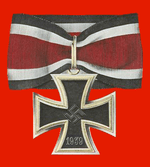Heinrich Kittel
| Heinrich Kittel | |
|---|---|
 Heinrich Kittel | |
| Born |
31 October 1892 Gerolzhofen |
| Died |
5 March 1969 (aged 76) Ansbach |
| Allegiance |
|
| Service/branch | Heer |
| Years of service | 1911–45 |
| Rank | Generalleutnant |
| Commands held | 462. Volksgrenadier-Division |
| Battles/wars |
|
| Awards | Knight's Cross of the Iron Cross |
Heinrich Kittel (31 October 1892 – 5 March 1969) was a highly decorated Generalleutnant in the Wehrmacht during World War II. He was a recipient of the Knight's Cross of the Iron Cross, awarded to recognise extreme battlefield bravery or successful military leadership. Heinrich Kittel was wounded and captured by American troops on 22 November 1944 during the Battle of Metz. He was held in captivity until 1947.
According to one review of Soldaten: Secret WWII Transcripts of German POWs by Sönke Neitzel & Harald Welzer, Heinrich Kittel's transcripts (in conversation with another P.O.W.) illustrate his culpable passivity while observing mass executions without intervening at all despite his rank: "Kittel (very excited): 'They seized three-year old children by the hair, held them up and shot them with a pistol and then threw them in. I saw that for myself. One could watch it; the SD [Sicherheitsdienst, the Security Service of the SS] had roped the area off and the people were standing watching from about 300 m. off. The Latvians and the German soldiers were just standing there, looking on'." Kittel, according to the reviewer, ignobly, perhaps criminally, failed to act, despite the [reviewer's] presumption that his high rank could have enabled him to do so.[1]
Awards and decorations
- Iron Cross (1914)
- 2nd Class
- 1st Class
- Eiserner Halbmond
- Knight's Cross of the Royal House Order of Hohenzollern with Swords
- Honour Cross of the World War 1914/1918
- Anschluss Medal
- Sudetenland Medal with Prague Castle Bar
- Iron Cross (1939)
- 2nd Class
- 1st Class
- Order of the Cross of Liberty 1st Class with Swords (23 August 1942)
- German Cross in Gold (23 February 1944)
- Knight's Cross of the Iron Cross on 12 August 1944 as Generalmajor and combat commander of Lemberg[2]
References
Citations
- ↑ ‘Soldaten: Secret WWII Transcripts of German POWs’ by Soenke Neitzel & Harald Welzer Daily Beast
- ↑ Fellgiebel 2000, p. 211.
Bibliography
- Fellgiebel, Walther-Peer (2000) [1986]. Die Träger des Ritterkreuzes des Eisernen Kreuzes 1939–1945 — Die Inhaber der höchsten Auszeichnung des Zweiten Weltkrieges aller Wehrmachtteile [The Bearers of the Knight's Cross of the Iron Cross 1939–1945 — The Owners of the Highest Award of the Second World War of all Wehrmacht Branches] (in German). Friedberg, Germany: Podzun-Pallas. ISBN 978-3-7909-0284-6.
- Patzwall, Klaus D.; Scherzer, Veit (2001). Das Deutsche Kreuz 1941 – 1945 Geschichte und Inhaber Band II [The German Cross 1941 – 1945 History and Recipients Volume 2] (in German). Norderstedt, Germany: Verlag Klaus D. Patzwall. ISBN 978-3-931533-45-8.
- Scherzer, Veit (2007). Die Ritterkreuzträger 1939–1945 Die Inhaber des Ritterkreuzes des Eisernen Kreuzes 1939 von Heer, Luftwaffe, Kriegsmarine, Waffen-SS, Volkssturm sowie mit Deutschland verbündeter Streitkräfte nach den Unterlagen des Bundesarchives [The Knight's Cross Bearers 1939–1945 The Holders of the Knight's Cross of the Iron Cross 1939 by Army, Air Force, Navy, Waffen-SS, Volkssturm and Allied Forces with Germany According to the Documents of the Federal Archives] (in German). Jena, Germany: Scherzers Miltaer-Verlag. ISBN 978-3-938845-17-2.
| Military offices | ||
|---|---|---|
| Preceded by Previously 462. Infanterie-Division |
Commander of 462. Volksgrenadier-Division 14 November 1944 – 22 November 1944 |
Succeeded by Oberst Joachim Wagner |
